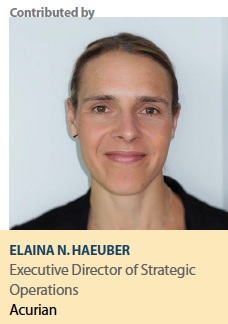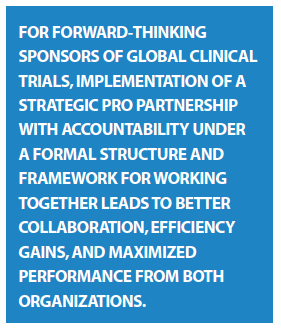 Sponsors of global clinical trials increasingly need a strategic partner for their patient enrollment challenges, as opposed to enlisting an array of outsourced tactical vendors through a standard RFP process. Why have such partnerships become critical for on-time trial completion? There are a number of reasons.
Sponsors of global clinical trials increasingly need a strategic partner for their patient enrollment challenges, as opposed to enlisting an array of outsourced tactical vendors through a standard RFP process. Why have such partnerships become critical for on-time trial completion? There are a number of reasons.
In general, the industry’s standard approach to recruitment is passive, deriving enrollment feasibility from what sites expect to deliver, and then predicating the entire trial’s success (or failure) on these subjective opinions. For this reason, most Contract Research Organizations (CROs) or recruitment vendors do not guarantee or even predict the actual yield or cost of patient enrollment, which is now the single biggest part of the total trial budget (approximately one-third). Meanwhile, site enrollment productivity continues to plummet, further underscoring the flawed nature of site-first feasibility and belated reliance on vendors to rescue enrollment that has gone off the tracks.
However, outsourcing to a Patient Recruitment Organization (PRO) that has quantifiable experience working with sites, and prices its services on measurable enrollment milestones, has become the successful formula for on-time enrollment. In fact, the top providers of proven and accountable enrollment services have been used by roughly 30% to 40% of sponsor respondents surveyed.1
As sponsors become more dependent on PROs to meet program and project timelines, there is an opportunity to alter the structure of the relationship. Rather than relying on tactical engagements, sponsors are encouraged to consider formation of strategic partnerships aligned to a formal governance framework, similar to what may be in place with their CRO partners.
 Under this structure, an outsourcing partner for patient enrollment can be responsible for providing strategic direction for recruitment in relationship to the sponsor’s pipeline/portfolio; program, project, and site performance management; metrics; forecasts; and issue resolution/escalation. Even more importantly, both organizations benefit from the application of lessons learned and implementation of process improvements to continue maximizing performance. With open sharing of intelligence between the sponsor and PRO, and setting of mutual expectations from the outset with shared accountability, efficient and on-time recruitment can be achieved.
Under this structure, an outsourcing partner for patient enrollment can be responsible for providing strategic direction for recruitment in relationship to the sponsor’s pipeline/portfolio; program, project, and site performance management; metrics; forecasts; and issue resolution/escalation. Even more importantly, both organizations benefit from the application of lessons learned and implementation of process improvements to continue maximizing performance. With open sharing of intelligence between the sponsor and PRO, and setting of mutual expectations from the outset with shared accountability, efficient and on-time recruitment can be achieved.
Patient Centricity and Early Engagement
The Patient Recruitment Organization can help the sponsor recognize that meeting or accelerating the recruitment goal is not simply a matter of adding sites. That is, not all patients in a clinical trial come from a site’s own database: out-of-practice patients must also be targeted. The sponsor mindset needs to change from site-first feasibility to patient-first feasibility, becoming proactive instead of passive. By planning the trial with the patients in mind first, all other options become outlets to gain access to the patients. Increased focus on the patient also leads to greater patient compliance and retention.
Early engagement with a PRO provides a value-add by applying this patient-centric strategy as well as industry best practices in initial trial planning, e.g.:
Evaluation of competition in the indication
Review of recruitment activities and results for past indication studies (including site performance and patient eligibility)
Development of patient pathways to mitigate challenges, capitalize on patient motivations to benefit enrollment, and understand the barriers that will detract from enrollment
Recommendations by country for central recruitment.
Together, the sponsor and PRO can identify opportunities for flexibility, innovation and optimization, such as:
Quantifying a rate of recruited patients as another lever in study enrollment planning
Incorporating patient insights into protocol design
Influencing timelines
Influencing site/country plans (e.g., numbers of sites/countries to maximize efficiency)
Quantifying the need for enrollment support to proactively secure a budget for central recruitment, rather than having to rescue a study that is behind in enrollment.
Site Network Models
A model by which the sponsor pays a per-patient fee, inclusive of all site-based and enrollment costs, can be the ultimate in accountability and enrollment certainty. In this type of arrangement, sponsors also benefit from faster site start-up, simplified project management, and more consistent, high-quality trial data. This approach still starts with a strategic, patient-first approach to enrollment feasibility and study planning, with additional efficiencies driven by closed-loop site footprints that place more responsibility on the service providers to reduce overall study costs while ensuring on-time enrollment.
For forward-thinking sponsors of global clinical trials, implementation of a strategic PRO partnership with accountability under a formal structure and framework for working together leads to better collaboration, efficiency gains, and maximized performance from both organizations. (PV)
Editor’s Note: 1 ISRreports.com, 2014, Whitepaper: The Expanding Web of Clinical Trial Patient Recruitment.
Acurian, a subsidiary of PPD, is the leading full-service global provider of clinical trial patient enrollment and retention solutions for the life sciences industry.
For more information, visit acurian.com.











